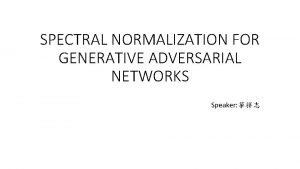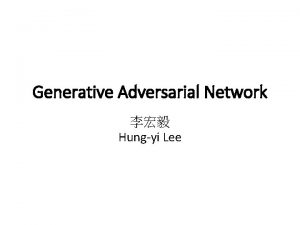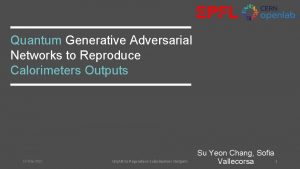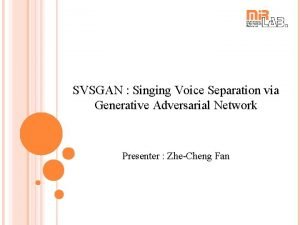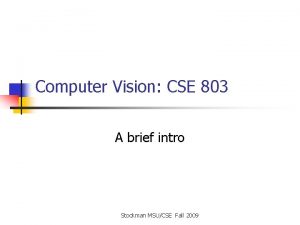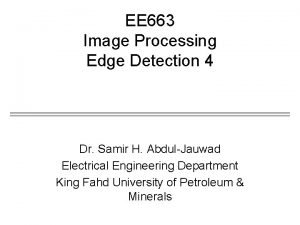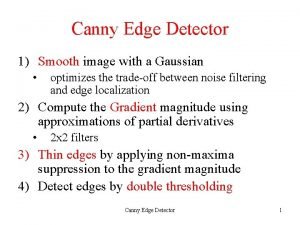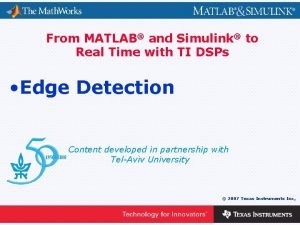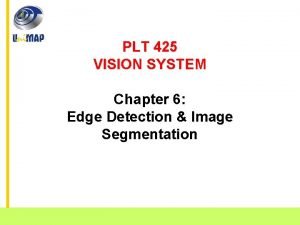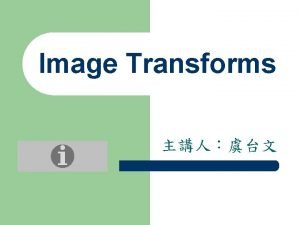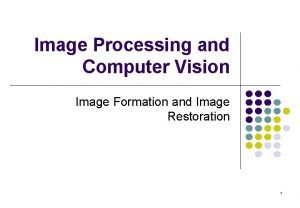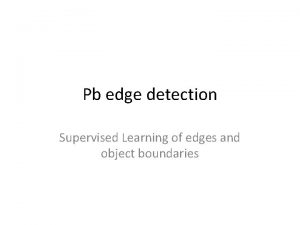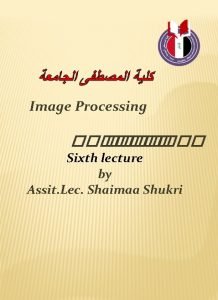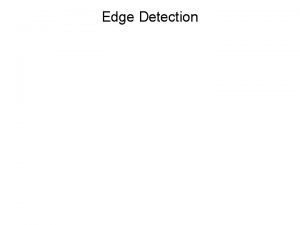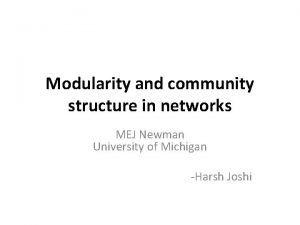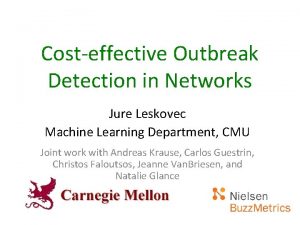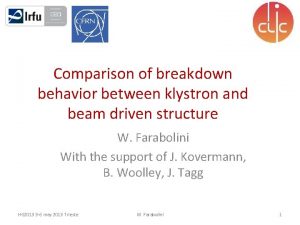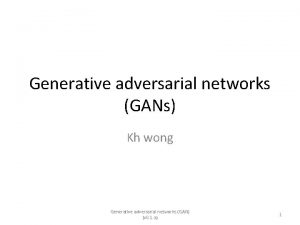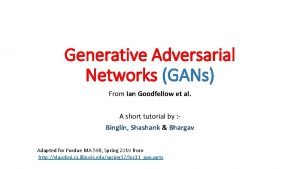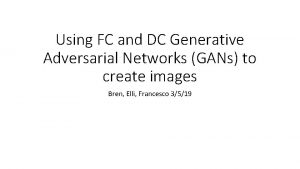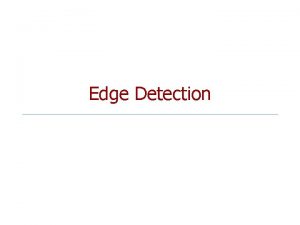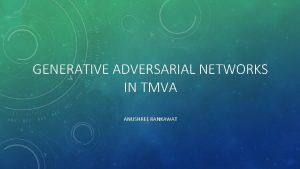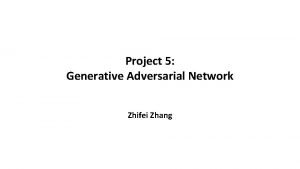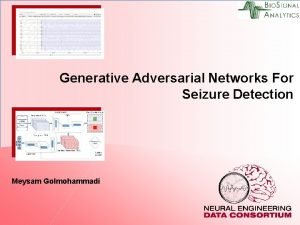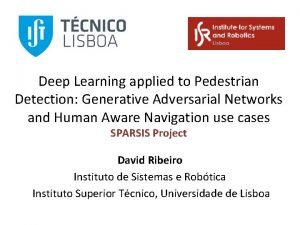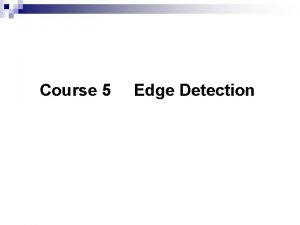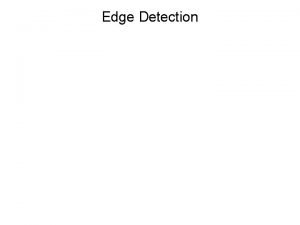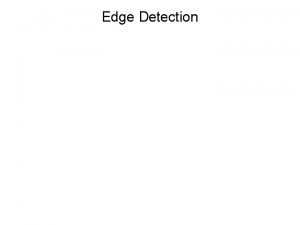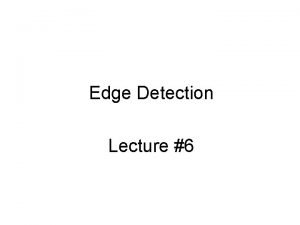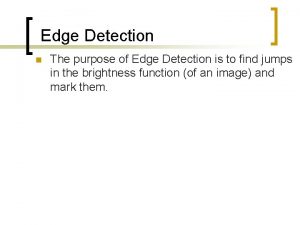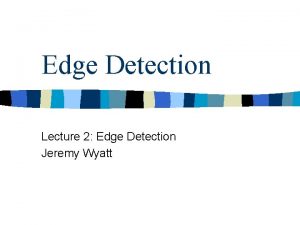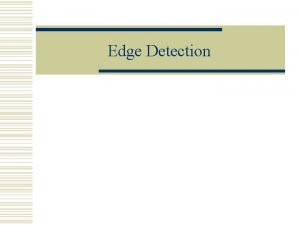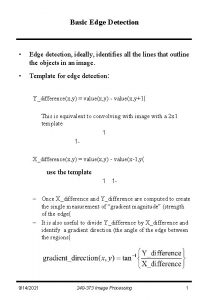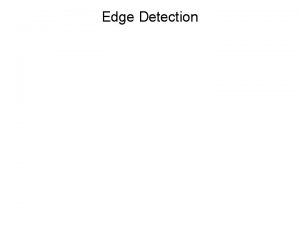Generative adversarial networks GANs for edge detection Z

























- Slides: 25

Generative adversarial networks (GANs) for edge detection Z. Zeng Y. K. Yu, K. H. Wong In IEEE iciev 2018, International Conference on Informatics, Electronics & Vision 'June, kitakyushu exhibition center, japan, 25~29, 2018. (http: //cennser. org/ICIEV/scope-topics. html) IEEE iciev 2018 Adversarial Network for edge detection (v 1 e) 1

Overview • • • Introduction Background Theory Experiment Discussions / Future work Conclusion IEEE iciev 2018 Adversarial Network for edge detection (v 1 e) 2

Introduction • What is edge detection? • Why edge detection? • What are the problems? – Single pixel width requirement, non-maximum suppression • How to solve the problem: Machine learning approach • Our results. IEEE iciev 2018 Adversarial Network for edge detection (v 1 e) 3

Background of edge detection • Traditional methods – Sobel, etc. – Canny • Machine learning methods – CNN methods – RCF (state of the art) – Generative adversarial networks (GANs) – Conditional GAN (c. GANs) – c. GAN with U-NET (=our approach, first team to apply c. GAN for edge detection) https: //lmb. informatik. uni-freiburg. de/people/ronneber/u-net/ IEEE iciev 2018 Adversarial Network for edge detection (v 1 e) 4

Theory of Generative adversarial networks (GAN) • GAN • Discriminator (D) • Generator(G) IEEE iciev 2018 Adversarial Network for edge detection (v 1 e) 5

Application of GAN • Generate data with the same distribution of training samples • Application : Enrich data sets, e. g. use some data in MINST dataset to train G, so G can generate more training samples. • Good for face datasets etc. MINST dataset: http: //yann. lecun. com/exdb/mnist/ IEEE iciev 2018 Adversarial Network for edge detection (v 1 e) 6

The idea, from : Goodfellow, Ian, et al. "Generative adversarial nets. " Advances in neural information processing systems. 2014. https: //arxiv. org/abs/1406. 2661 • The proposed adversarial nets framework, the generative model is pitted against an adversary: • a discriminative model (D) that learns to determine whether a sample is from the model distribution or the data distribution. The generative model (G) can be thought of as analogous to a team of counterfeiters, trying to produce fake currency and use it without detection, while the discriminative model is analogous to the police, trying to detect the counterfeit currency. Competition in this game drives both teams to improve their methods until the counterfeits are indistinguishable from the genuine articles. IEEE iciev 2018 Adversarial Network for edge detection (v 1 e) 7

The concept of a generator G • Input noise z (with distribution pg) to a generator G which can produce output data • Application example: You train G using many samples of handwritten character images (from MINST dataset), after training you input a noise z (with distribution pg ), then G will give you an image of a handwritten character. • Usage: create more training data for machine leaning systems Z (distribution pg): a vector G can generate data according to Z Output is a picture of a hand written character MINST dataset: http: //yann. lecun. com/exdb/mnist/ IEEE iciev 2018 Adversarial Network for edge detection (v 1 e)

GAN training procedure https: //arxiv. org/abs/1406. 2661 The training Algorithm Step 1 Training images with distribution pdata x Train parameters of discriminator D: d First train D (discriminator) CNN i. Send a new batch of training data to D, with label 1=‘real images’ One scalar: Label=‘ 1’ when training ii. Can loop (1) many times , e. g. Train D to maximize the probability of from 1 to 10 times. assigning the correct label to training examples, (and samples from G, in step 2) 2) Keep D and train G (generator) i. sending noise to G so that the Step 2 Noise (z) with distribution P (a vector) output should be labeled as ‘ 0 z =‘fake image’ Train parameters g of generator G: ii. Can loop (2) many times , e. g. CNN from 1 to 10 times. Image generated 3) Go to 1, until D output is 0. 5 1) Both D (parameters d ) and G (parameters g ) are CNN Convolution neural networks. IEEE iciev 2018 Adversarial Network for edge detection (v 1 e) Keep D: CNN One scalar: Label=‘ 0’ when training Train G to minimize log(1 -D(G(z)) 9

The idea Blue dashed error (D) Green solid Pg (move closer to Px) Black dotted Px=data (from x true data) Green solid Pg (G generated fake) Blue dashed (D)=1/2 x=real samples z=noise with a known distribution (uniform this case) • Figure 1: Generative adversarial nets are trained by simultaneously updating the discriminative distribution (D, blue, dashed line) so that it discriminates between samples from the data generating distribution (black, dotted line) Px from those of the generative distribution Pg (G) (green, solid line). The lower horizontal line is the domain from which z is sampled, in this case uniformly. The horizontal line above is part of the domain of x. The upward arrows show the mapping x = G(z) imposes the non-uniform distribution Pg on transformed samples. G contracts in regions of high density and expands in regions of low density of Pg. (a) Consider an adversarial pair near convergence: Pg is similar to pdata and D is a partially accurate classifier. (b) In the inner loop of the algorithm D is trained to discriminate samples from data, converging to D(x) = pdata(x)+pg(x). (c) After an update to G, gradient of D has guided G(z) to flow to regions that are more likely to be classified as data. (d) After several steps of training, if G and D have enough capacity, they will reach a point at which both cannot improve because pg = pdata. The discriminator is unable to differentiate between the two distributions, i. e. D(x) = 1/2. IEEE iciev 2018 Adversarial Network for edge detection (v 1 e) 10

Theory of conditional GAN (c. GAN) • GAN is difficult to train because the search space is too large. • Add condition (prior y) to GAN • Compare formulas – GAN – c. GAN https: //arxiv. org/pdf/1411. 1784. pdf Conditional Generative Adversarial Nets by Mehdi Mirza IEEE iciev 2018 Adversarial Network for edge detection (v 1 e) 11

Theory of conditional GAN (c. GAN) • GAN is difficult to train because the search space is too large. • Add condition (prior y, usually a label) to GAN D(x|y) Conditions added: so can generate different testing sets Condition y G(z|y) 0 1 2 3 4 5 6 7 8 9 IEEE iciev 2018 Adversarial Network for 12 edge detection (v 1 e) https: //arxiv. org/pdf/1411. 1784. pdf Conditional Generative Adversarial Nets by Mehdi Mirza

Our approach: Theory of conditional Generative adversarial networks(c. GAN) Fake example Real example • x=real image sample • Y=real edge of x • y*=false (generated) edge • To optimze Real = label ‘ 1’ Fake = label ‘ 0’ Fake Real edges IEEE iciev 2018 Adversarial Network for edge detection (v 1 e) Real image 13

• • The training data set has 1440 batches 1 batch has 20 edge-image pairs. Each image =256 x 3 integers(color) edge image =256 x 1 binary G (CNN 3 x 3 kernel network): – – – Input: 256 x 3 integers Output 256 x 1 binary (real or fake) G has 5 stages • • Fake example Real = label ‘ 1’ Stage 1: 2 layers (256 xdim) Stage 2: 2 layers (128 xdim) Stage 3: 3 layers Stage 4: 3 layers Stage 5: 3 layers Plus 2 predict layer D (CNN network): – – – • Our implementation procedures Input: 256 x 4 (image + edge) concatenation Output: 1 binary (represents real or fake) same as VGG: 16 layers Training procedures – – – Step 1: Get a new batch of 20 Paris (real + edge) Step 2: Positive example side: feed 1 batch to train D with target output label real (1) Step 1: Negative example side: Keep D, train G with target output label fake (0) Repeat Step 1, 2, 3 until output on Negative example side of D is 0. 5. That means D cannot tell if the generated edge image is rea l or fake Usually 9000 iterations will get D produce 0. 5 to complete the training Fake = label ‘ 0’ Fake 256 x 1 binary Real edges Real image IEEE iciev 2018 Adversarial Network for edge detection (v 1 e) 256 x 3 integer Real image 14

Positive/negative sample balancing problem • Fake example Real = label ‘ 1’ Fake = label ‘ 0’ Fake Real edges IEEE iciev 2018 Adversarial Network for edge detection (v 1 e) Real image 15

Overall objective function • Fake example Real = label ‘ 1’ Fake = label ‘ 0’ Fake Real edges IEEE iciev 2018 Adversarial Network for edge detection (v 1 e) Real image 16

De-Convolution layer https: //datascience. stackexchange. com/questions/6107/what-are-deconvolutional-layers • IEEE iciev 2018 Adversarial Network for edge detection (v 1 e) 17

More de-convolution demo https: //github. com/vdumoulin/conv_arithmetic Convolution: No padding No strides Input=4 x 4 image Kernel=3 x 3 Output =2 x 2 De-convolution: No padding No strides Input=2 x 2 image Kernel=3 x 3 Output =4 x 4 • IEEE iciev 2018 Adversarial Network for edge detection (v 1 e) 18

U-Net From: Image-to-Image Translation with Conditional Adversarial Networks Phillip Isola Jun-Yan Zhu Tinghui Zhou Alexei A. Efros https: //arxiv. org/pdf/1611. 07004. pdf • Figure 3: Two choices for the architecture of the generator. The “U-Net” [49] is an encoderdecoder with skip connections between mirrored layers in the encoder and decoder stacks. convolution De-convolution (transpose convolution) IEEE iciev 2018 Adversarial Network for edge detection (v 1 e) 19

Modified U-net • IEEE iciev 2018 Adversarial Network for edge detection (v 1 e) 20

Result • • Figure 1. We build a simple generator network based on UNET [25] to produce the edge map. Since RCF [23] and HED [28] contains multiple output, we only compare the final output of both network, which denote as RCF 6 and HED 6. We show two image examples here. One can clearly see that our result contains more detail information, and produce thinner edge even without apply the non-maximum suppression method. IEEE iciev 2018 Adversarial Network for edge detection (v 1 e) 21

Result • IEEE iciev 2018 Adversarial Network for edge detection (v 1 e) 22

• • • To compare with other edge detection methods, we used the same evaluation metric to illustrate our edge detection results. Normally, a threshold is necessary to produce the final edge map when an edge probability map is given. There are various methods to determine threshold, out of which two wellknown evaluation metrics can be used. The first one is called the optimal dataset scale (ODS), which applies a fixed threshold for all edge probability maps. The second one is known as the optimal image scale (OIS), which tries to apply different thresholds to the images and then selects the optimal one from the trial values. For both ODS and OIS, we used Fmeasure to compare the algorithm performances. The formula can be expressed as ( 2 Precision. Recall Precision+Recall ). Results Ours IEEE iciev 2018 Adversarial Network for edge detection (v 1 e) 23

Discussions/ Future work • IEEE iciev 2018 Adversarial Network for edge detection (v 1 e) 24

Conclusions • we have devised an innovative edge detection algorithm based on generative adversarial network. • Our approach achieved ODS and OIS scores on natural images that are comparable to the state-of-the-art methods. Our model is computation efficient. • It took 0. 016 seconds to compute the edges from an image having a resolution of 224 X 3 with GPU. For a 512 X image, it took 0. 038 seconds. Our algorithm is devised based on the UNET and the conditional generative adversarial neural network (c. GAN) architecture. • It is different from the convolutional networks in a way that c. GAN can produce an image which is close to the real one. • Therefore, the edges resulting from the c. GAN generator is much thinner compared to that from the existing convolutional networks. • Even without using any pre-trained network parameters, the proposed method is still able to produce high quality edge images. IEEE iciev 2018 Adversarial Network for edge detection (v 1 e) 25
 Melody randford
Melody randford Spectral normalization gan
Spectral normalization gan Generative adversarial networks
Generative adversarial networks Quantum generative adversarial learning
Quantum generative adversarial learning Singing
Singing Edging nnn
Edging nnn Convolution edge detection
Convolution edge detection Edge detection
Edge detection Normalized cut segmentation
Normalized cut segmentation Stockman
Stockman Edge detection
Edge detection Edge detection
Edge detection What is canny edge detection in image processing
What is canny edge detection in image processing Simulink edge detection
Simulink edge detection Edge detection
Edge detection Edge detection
Edge detection Roberts edge detection
Roberts edge detection Edge detection
Edge detection Edge detection sobel
Edge detection sobel Edge detection
Edge detection Community detection in networks
Community detection in networks What is crc in computer network
What is crc in computer network Cost-effective outbreak detection in networks
Cost-effective outbreak detection in networks Checksum in computer networks with example
Checksum in computer networks with example Error detection and correction in computer networks
Error detection and correction in computer networks Rising edge and falling edge
Rising edge and falling edge

